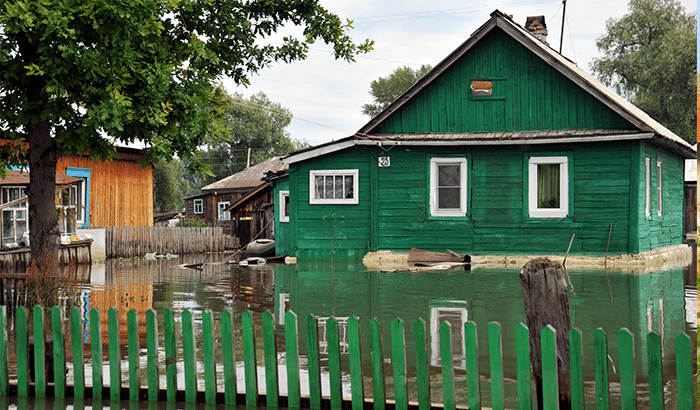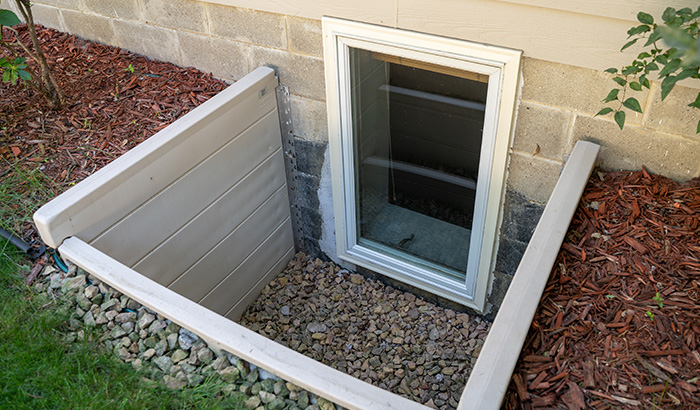There’s nothing that can send a shock wave of panic through a homeowner like a flooding window well. Water leaking into your basement can quickly and seriously damage appliances, walls, finish work and even some of your home’s major systems like the HVAC or electrical. But what can be done? Is there a way to fix a window well that keeps flooding? Here’s everything you need to know.
Why Do Some Window Wells Flood?
The most common reason for a flooding window well is a clogged or missing drain. Every window well should have a central drain at the bottom linked to a more extensive drainage system. As long as these drains stay clear and unclogged, water should flow easily through them instead of making its way into your basement.
Occasionally, contractors will install window wells without a drain to get more light to the basement. Light is a good thing, but water coming into the basement is not. All it takes is one heavy rainstorm to bring a homeowner into the basement, bailing water back out of the window with a bucket.
Other problems with flooding can arise when the drains aren’t correctly sized for your window well. A small drain won’t be able to keep up with a heavy storm or excess water from oversaturated soil. Likewise, an incorrectly sized window well can cause problems if it’s not deep enough or broad enough to fit the window correctly.
Finally, the gravel and soil layers in your window well are all part of the drainage system. So if your window well is flooding, that’s an indicator that something isn’t right with one of these things.
Fix a Flooding Window Well With These Steps
If you’ve noticed any water leaking or flooding into your home from your window well, here’s a look at the steps you can take to fix the problem.
Step 1: Remove Water
Before you even worry about the window well, the obvious first step is to get any water out of your basement. If there’s only a trickle of moisture, your job is easy. Simply wipe it up and put a towel at the source to block any more water from entering. If your situation is more extreme, this process might take longer. You might find a wet/dry vacuum helpful in removing water from the walls and floors, but a bucket is more useful if there’s a high water level.
Whatever method you choose to remove the water, act quickly. If the damage is severe, consider calling a professional water damage repair company since they have the right tools to quickly remove water as to prevent mold growth. Several large fans set up over the walls and floors will help dry the area out and stop mold spores from even starting.
Step 2: Drain the Window Well
When you finally have all the water removed from the inside of your home, it is time to move outdoors. Use a bucket to empty all of the water from inside the window well. You will probably find a mess of mud and gravel at the bottom. Dig around inside of there until you find the drain cover, and then clear away all the sludge so you can diagnose the problem.
Step 3: Identify the Source of the Leak
The most common cause of a window well flood is a clogged drain, so check that first. Over time, it is common for mud, leaves, sticks and other debris to clog up the drainage system, preventing water from escaping through the drain. It is also possible the home builder did not correctly install the drain, and subsequently, there is no drainpipe below to move the water away from your home. If you can identify the problem, do your best to fix it or consider calling a professional.
Step 4: Take Preventative Measures
One of the most effective ways to stop window wells from flooding is to prevent water from building up inside the wells. These features are essential to avoid further basement flooding from leaky window wells:
- A Working Drain
Properly installed window wells have a drainpipe placed at the bottom that leads away from the home’s foundation. The drainpipe should exit at a slope and connect to a gutter drain. Alternatively, the drainpipe can lead inside the basement and connect to your home’s sump pump system. A properly sized drain can go a long way to preventing basement floods.
- Well-Fitting Window Well Covers
Even a properly installed window well drain can’t function when it gets clogged, and the best way to prevent a clogged drain is to keep debris out of the window well altogether. You can purchase and install window well covers made specifically for your home to prevent dirt and leaves from clogging the drain pathway and prevent small animals from building homes inside. We recommend finding one made of polycarbonate resin for lightweight strength and durability. Window well covers contribute to your home’s aesthetic and protect your window wells while still allowing light inside your home.
- Regular Window Well Cleaning
Even if you’ve got a proper drainage system and a window well cover, regular cleaning and maintenance are essential to preventing flooding. Check the drainpipe for clogs and least twice a year, and make sure the cover fits snugly over your window well and liner.
Windowell Expressions Can Help
Are you tired of cleaning up from a flooding window well time and time again? Windowell Expressions is here to help. We build custom window well covers that will keep the water out while still allowing in the light and sunshine.
We also offer decorative foundation and window well liners, adjustable window well grates, and more to keep your property looking top-notch. We’re always happy to customize well covers to fit your specific needs, but we offer standard sizes as well.
We operate from Salt Lake City, Utah, and serve customers across the Wasatch Front. See what Windowell Expressions can do for you. Get a free quote today!







